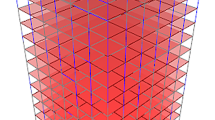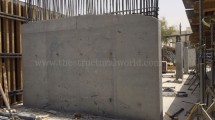Abstract
Seismic response control strategies of buildings are the preventive measures against catastrophic damage in the event of an earthquake. The seismic response control of buildings improves their performance during earthquakes and was first proposed more than a century ago, but it came into practice only in the last 30 years. Several seismic response control strategies emerged to lessen the consequences of the destructive seismic loads. More popular seismic response control strategies the are addition of shear walls and base isolation. A comparative study is conducted to access the effectiveness of these two control strategies. A five-storied building is considered for this purpose and modeled in SAP2000 software. In one building, shear wall is designed and added, to resist lateral loads. In the other building with similar dimensions, base isolation is designed to resist lateral loads. Wide column method is used for modeling the shear wall. Rubber isolator element available in SAP2000 software is used for modeling the base isolation. Inferences are being drawn on the seismic behavior of each case. Construction feasibility of each case is also discussed.
Access provided by Autonomous University of Puebla. Download conference paper PDF
Similar content being viewed by others
Keywords
1 Introduction
An earthquake is a devastating natural disaster that potentially threatens life, destroys property, and disrupts essential services and public functioning. Natural catastrophes like earthquakes, floods, landslides, cyclones, and tsunamis frequently occur in India. Large-scale earthquakes have had an especially negative impact on India in recent decades. Therefore, there is an urgent need for an earthquake-resistance management strategy to minimize damage to buildings in the event of an earthquake.
The primary strategy for enhancing seismic performance and damage prevention of buildings is that of seismic response control strategies like passive, semi-active, and active control strategies. Addition of base isolation and shear wall as passive seismic response control system will help in controlling the seismic response of building. Structural response control is an emerging technology for seismic hazard mitigation in earthquake engineering and has been widely studied over the world. Whittaker [5] de-mystifies preliminary design of base-isolation systems in accordance with international earthquake design standard. Hadihosseini et al. [6] provide the structural performance of a framed building with shear wall. Rama Rao et al. [2] discuss the SAP2000 modeling of framed buildings with in-fills and supporting soil modeling. Rama Rao et al. [4] discuss a parametric study on the nonlinear ductile behavior of shear wall using ABAQUS finite element software. Rama Rao et al. [3] studied the nonlinear performance of three identical medium aspect ratio shear walls through application of monotonic and cyclic loading.
A number of research studies are available for each seismic response control strategy, however, comparative studies on the effectiveness of various seismic response control strategies are found to be scarce. A comparative study is conducted between these two control strategies. A five-storied building is considered for the present study and modeled in SAP2000 software using linear time history analysis. Newhall ground motion data, taken from SAP2000 database, is used for analyses. In one building, shear wall is designed and added, to resist seismic ground motions. In the other building with similar dimensions, base isolation is designed to resist seismic ground motions.
1.1 Base Isolation
The philosophy of seismic resistant design is undergoing a rapid change with emphasis on preserving the structure and its interiors intact and without letting them into nonlinear range. The best possible potential alternative is mounting of the structure on flexible elements which are replaced after a severe earthquake but the parent structure is prevented from damage. The fundamental idea is to extend the structure’s time period such that the spectral acceleration is minimized. The inter-story drift is decreased since the superstructure essentially functions like a rigid body. The isolation moves the structure’s position in the spectrum from the peak-plateau region to the lower regions by lowering the fundamental lateral frequency of the structure relative to its fixed base frequency (or lengthening the structure’s time period). Because of this, higher damping is introduced at the base level as a result, and more damping is also produced, which further reduces the spectral acceleration. The benefit of using a base-isolation system is that in the event of an unexpected large-scale seismic activity, the damage is concentrated only on systems whose elements can be replaced.
1.2 Shear Wall
Shear walls are structural walls that are specifically built into structures to withstand lateral stresses that are created in the wall’s plane by wind, earthquakes, and other factors. They are typically given in tall structures and have been found to be of great assistance in preventing the complete collapse of buildings under seismic forces. When designing shear walls, we should aim to load them with as much weight as they can safely support in order to minimize the bending tensile stresses brought on by lateral loads. In order to prevent torsional strains, they should also be laid symmetrically. Figure 2 shows the placement of shear wall symmetrically in a building to reduce torsion effects.
Shear walls are categorized by type: simple rectangular and with bounding elements, coupled shear walls, and boxed walls. A simple rectangular type is taken into consideration where normal gravity load and horizontal shear action along its length are subjected to bending and shearing. These latter types are called bar walls (rectangular walls with bounding elements) and are somewhat stronger and more ductile. These walls must be designed so that they never fail under shear forces and do not fail due to deformation of the steel when bent. Shear failure is fragile and sudden. One of the disadvantages of this shear wall is that as these being rigid, during an earthquake, it attracts and dissipates a lot of energy by cracking, which is difficult in repair. This defect can be rectified in coupled shear walls. When two structural walls are connected by relatively short spandrel beams, the resulting wall becomes more rigid and the structure is able to release the majority of the energy by yielding the coupling beams without causing structural damage to the primary walls. It is easy to repair these coupling beams than the walls. In some buildings, the elevators and other service areas can be grouped in a vertical core which may serve as a device to withstand lateral forces. In most of the cases, moment-resisting frames are connected to stiffening walls. The interaction between rigid walls and moment frames of tall buildings is worth studying. Frame deflection occurs in shear mode and walls in bending mode. This interaction tends to reduce the maximum bending moment but increases the maximum shear force in the shear wall.
2 Analytical Study on Seismic Response Control Strategies
The above two control strategies (shear wall and base isolation) are taken into consideration and applied to a five-storied building. The reference in case one is a normal framed construction. In the other cases, shear walls are added in one case while base isolation is used in the other.
2.1 Case Study—1: Normal Framed Building
In this study, we consider a five-story square building with five spans in both X and Y directions. For this research, SAP2000 software is adopted. The structural model selected for the analytical study is designed as per IS 456:2000 [7] and linear time history analysis is performed. A 4 m bay width is common to all bays and a 3 m floor height is common to all floors. Beams and columns are modeled using 3D framing components. Figure 1 shows a 3D SAP2000 model of a normal frame building. The assumed beams and columns are given its cross-section dimensions, reinforcement details, and the type of material used. Material properties such as specific gravity, modulus of elasticity, Poisson’s ratio, shear modulus of elasticity, specific compressive strength, yield strength, and ultimate stress of reinforcing steel and concrete are presented.
M25 grade concrete and Fe415 grade steel are the materials used. For all the simulations, a column with dimensions of 350 mm, 300 mm, and a 300 mm depth that is orientated in the X-direction is considered. Eight no’s of 16 mm diameter bars are used for the column’s longitudinal reinforcement, and 6 mm stirrups are used for the column’s transverse reinforcement at 150 mm c/c. With six no’s of 16 mm diameter bars and 6 mm diameter (as per IS 456), stirrups at 150 mm center-to-center; 300 mm × 300 mm beam is used. To account for the impact of cracking, the moment of inertia of the beam and column have been modified by 0.5 and 0.7, respectively. The 120 mm slab thickness is taken into account. Outer brick infill walls are assumed to be 230 mm thick, while partition walls are assumed to be 115 mm thick. The infill wall is not modeled; however, the mass of the infill is considered and distributed on the beam. The unit weight of brick infill is taken as 20 kN/m3 where a 50% opening in the all-infill walls is considered.
The floor finish for typical floors is assumed to be 1.0 kN/m2 and the imposed load on the ceiling is assumed to be 2.0 kN/m2. According to IS 1893 Part 1 (2016) [1], live load is not considered for roof load. These structural data are listed in Table 1. In order to simulate the slab’s high in-plane stiffness, diaphragm constraint action is assigned at each floor level. Self-weight and loads acting on the slab are calculated separately as triangular loads and applied on the supporting beams. Beam and column connections were modeled by setting end length offsets for frame members. Dead load and live loads are applied as gravity loads. The importance factor is assumed to be 1.0, and the response reduction factor is assumed to be 3. Load combinations are considered as per IS 1893 (Part 1): 2016 [1]. A linear time history analysis has been performed in the X-direction (along the side of a 300 mm deep column) by applying Newhall earthquake date. Further, modal analysis is also performed. Table 2 shows the shear force, bending moment comparison of the critical column. The natural time period of the building is shown in Table 3. A comparison of inter-story drift is plotted in Fig. 6 and the top deflection of each floor is plotted in Fig. 5. The columns adopted for the study do not meet design seismic load calculations for zone-V, but only for the calculations for zone-III. To overcome this, a column size of 450 mm × 400 mm is used to meet the building design in zone-V with a depth of 400 mm oriented along the X axis where the longitudinal reinforcement in column is 12 no’s of 16 mm diameter reinforcements bars with 8 mm diameter stirrups at 150 mm c/c spacing.
2.2 Case Study—2: Framed Building with Shear Wall
In case study 2, all the geometric and material properties of case study 1 are used and additionally, and shear wall is added. The design of shear wall is carried out with an assumption that the shear wall will resist 50% of the lateral moment and remaining 50% will be resisted by columns in the framed system. Four shear walls are added on the four sides middle, in such a way that torsional stress will not occur. Different modeling methods are used to represent shear walls, including combinations of shell and frame parts. The most popular modeling method, also known as the wide column method, consists of a mid-pier frame to reflect the stiffness of the shear wall and a horizontal frame (rigid arm) to allow proper couplings with intersecting beams and slab components.
Shear wall is designed as per IS 13920: 2016 [8]. The designed shear wall has a width of 2.5 m and a thickness of 200 mm, each direction with two numbers. The main reinforcement of 12 mm diameter with a spacing of 200 mm c/c and lateral reinforcement of 10 mm diameter with a spacing 200 mm c/c are used. The short beam connecting the column and shear wall has a higher depth of 400 mm to sustain the bending moment of the shear wall. The materials used for shear wall are M25 grade concrete and Fe415 grade of steel. Figure 2 shows the 3D SAP2000 model of the framed building with shear wall. Linear time history analysis is performed in X-direction (along 300 mm depth side of column). The shear force, bending moment, and inter-story drift of critical column are given in Table 2; and the time period of the building is tabulated in Table 3. Building with column size 350 mm × 300 mm with shear wall is able to withstand the seismic zone-V. The top deflection of each floor is plotted in Fig. 5.
2.3 Case Study—3: Framed Building with Base Isolation
Similar to case study 2, all the geometric and material properties of case study 1 is used in case study 3 and additionally, instead of shear wall, base isolation is added. The design of base isolation is made with an assumption of 50% reduction in the seismic response.
Laminated rubber bearing isolator is one type of isolators and is considered for the present study. It has a vertical load carrying capacity and is made of rubber in alternating layers. Steel laminated plates at the top and bottom of these layers distribute vertical loads and transmit shear force to the internal rubber layer. A rubber cover that protects the steel laminated plates is included on the top and bottom of the plate. This isolator with much lower horizontal stiffness is introduced between foundation and the superstructure. Spectral acceleration decreases with an increase in the system’s natural period, which in turn reduces the force acting on the structure. But the system’s displacement dramatically rises. This is due to the deformation of the rubber layer.
Base-isolation design includes determining the size of isolator, height of isolator, number of rubber layers and steel plates provided, mass of the isolator, horizontal stiffness and vertical stiffness of isolator. The provisions for evaluating these properties are stated in IS 1893 (Part 6): 2022. In this study, a framed building with base isolation is designed as per IS 1893 (Part 6): 2022 and is shown in Fig. 3. The isolators are modeled as link elements by giving relevant properties in SAP2000 software. Figure 4 shows the SAP2000 Elevation view of the Base Isolated structure. The isolators are placed on the pedestals to support the building. Linear time history analysis and modal analysis have been performed.
3 Comparative Study
By performing linear time history analysis, the model is analyzed in each case. The story deflection, bending moment, and shear force value of the critical column are compared for all three cases, and the time period of the three cases is also tabulated when performing modal analysis.
4 Conclusion
This study presents an analytical evaluation of the seismic response of three buildings using two alternative seismic response control techniques.
-
By using linear time history analysis, the linear behavior of a framed building with a normal frame, a shear wall, and base isolation are compared.
-
From the study, it is observed that addition of shear wall has more effective and economical. Unlike base isolation, addition of shear wall doesn’t require special construction technology. Because of the limitations in the base isolation, it may be ideal for all cases.
-
We conclude that the construction of a shear wall reduces the natural period of the structure, increases lateral stiffness, and decreases bending moments and column shear stresses.
-
Shear wall construction as a response control is a more practical choice and possesses better construction feasibility for low to medium rise buildings.
References
IS 1893 (Part 1): 2016, Indian Standard—Criteria for earthquake resistant design of structures, Part-1, General provisions and buildings. Bureau of Indian Standards, New Delhi
Rama Rao GV, Sunil JC, Vijaya R (2021) Soil-structure interaction effects on seismic response of open ground storey buildings. Sadhana 46(2):105, 1–17
Rama Rao GV, Gopalakrishnan N, Jaya KP, Muthumani K, Reddy GR, Parulekar YM (2016) Studies on nonlinear behavior of shear walls of medium aspect ratio under monotonic and cyclic loading. ASCE J Perform Constr Facil 30(1):04014201
Rama Rao GV, Gopalakrishnan N, Jaya KP, Dhaduk RJ (2015) Studies on ductility of shear walls. J Struct Eng 42(6):540–549
Whittaker D (2007) Base isolation design made simple. In: 10th world conference on seismic isolation, energy dissipation and active vibrations
Hadihosseini M, Hoseeni AH (2014) Study the effective of shear wall on behavior of beam in frame structure. Am J Eng Res 03(10):188–202
IS 456 2000 Indian Standard Plain and reinforced concrete—code of practice. Bureau of Indian Standards, New Delhi
IS 13920 2016 Indian Standard Ductile design and detailing of reinforced concrete structures subjected to seismic forces—code of practice. Bureau of Indian Standards, New Delhi
Author information
Authors and Affiliations
Corresponding author
Editor information
Editors and Affiliations
Rights and permissions
Copyright information
© 2024 The Author(s), under exclusive license to Springer Nature Singapore Pte Ltd.
About this paper
Cite this paper
Jestalt Srisanth, J., Rama Rao, G.V., Senthil Velan, D. (2024). Seismic Response Control Strategies for Buildings. In: Gencel, O., Balasubramanian, M., Palanisamy, T. (eds) Sustainable Innovations in Construction Management. ICC IDEA 2023. Lecture Notes in Civil Engineering, vol 388. Springer, Singapore. https://doi.org/10.1007/978-981-99-6233-4_25
Download citation
DOI: https://doi.org/10.1007/978-981-99-6233-4_25
Published:
Publisher Name: Springer, Singapore
Print ISBN: 978-981-99-6232-7
Online ISBN: 978-981-99-6233-4
eBook Packages: EngineeringEngineering (R0)









